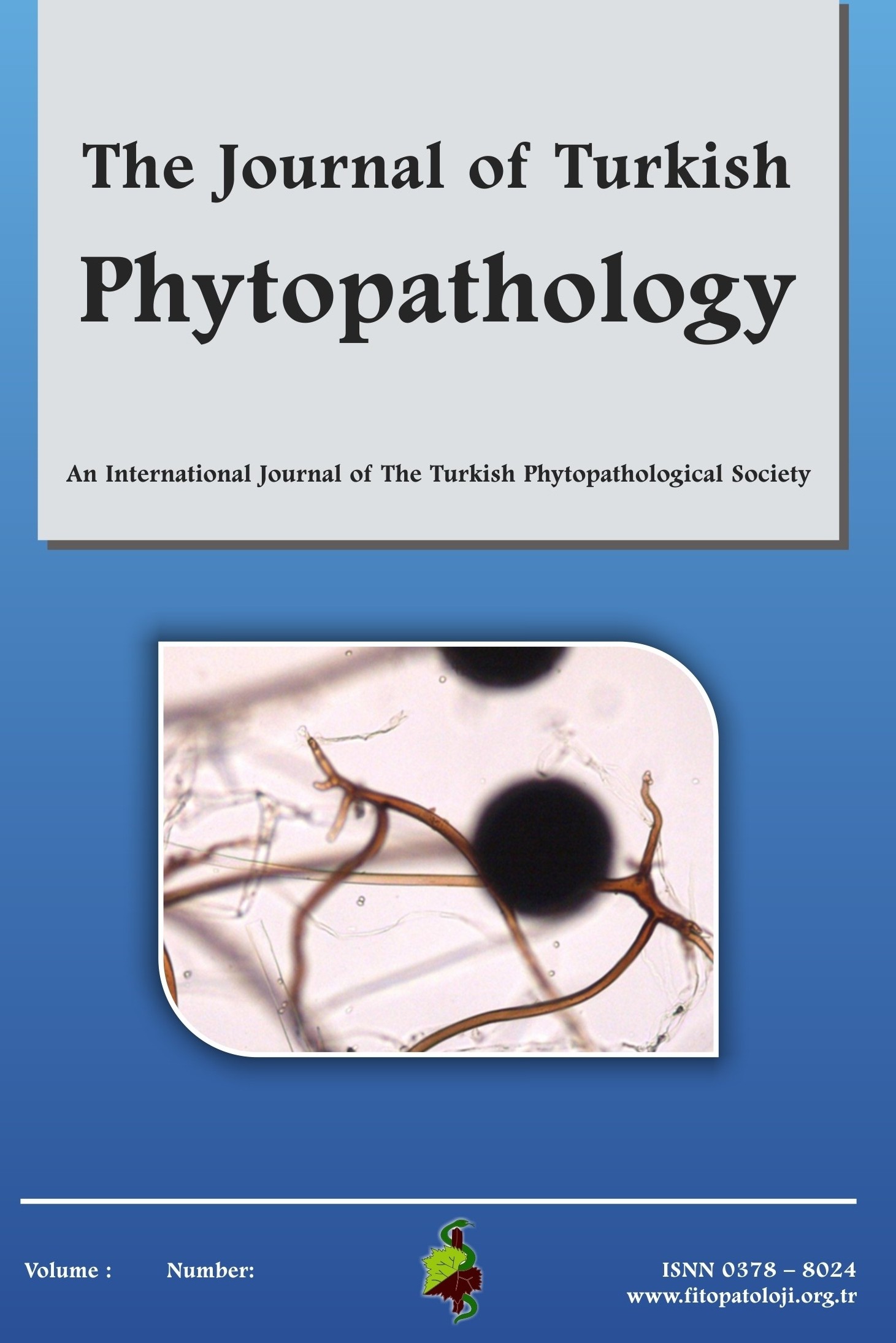Studies on Esca and Petri Diseases in Grapevine Nurseries and Vineyards in Aegean Region
Studies on Esca and Petri Diseases in Grapevine Nurseries and Vineyards in Aegean Region
Grapevine, Petri disease, Esca, Phaeoacremoniumaleophilum Phaeomoniella chlamydospora, Fomitiporia mediterrenea,
___
- Anonim. 2008. Zirai Mücadele Teknik Talimatları. Tarımsal Araştırmalar ve Politikalar Genel Müd., Ankara. Anonim. 2010. Türkiye İstatistik Kurumu.http://www.tuik.gov.tr/ (Erişim tarihi: 03.02.2012). Andolfi, A., Mugnai, L., Luque, J., Surico, G., Cimmino, A. and Evidente, A. 2011. Phytotoxins Produced by Fungi Associated with Grapevine Trunk Diseases.Toxins, 3(12): 1569-1605. Aroca, A., Garcia-Figueres, F., Bracamonte, L. and Raposo, R. 2006. A Survey of Trunk Disease Pathogens within Rootstocks of Grapevines in Spain. Europen Journal of Plant Pathology, 115:195-202. Crous, P.W. and Gams, W. 2000.Phaeomoniella chlamydospora gen. et comb. nov., a causal organism of Petri grapevine decline and esca, Phytopathologia Mediterranea 39: 112–118. Çelik H., Ağaoğlu, Y.S., Fidan, Y., Marasalı, B. ve Söylemezoğlu, G. 1998. Genel Bağcılık, Sunfidan A.Ş. Mesleki Kitaplar Serisi:1. Erkan, M. and Larıgnon, P. 1998. Fungi assosiated with esca disease in grapevines in the Aegen Region. Turkey, Journal Turkısh Phytopathology, 27 (2-3): 137-143. Erkan, M. 2000. A general approach for esca disease in the vineyards of Turkey. Phytopathologia Mediterranea, 39: 35-37. Eskalen, A., Rooney-Latham, S. and Gubler, W.D. 2005. Occurrence of Togninia fraxinopennsylvanica on Esca Diseased Grapevines (Vitis vinifera) and Declining Ash Trees (Fraxinus latifolia) in California. Plant Disease, 89(5): 528. Fischer, M. 2002. A new wood-decaying basidiomycete species associated with esca of grapevine: Fomitiporia mediterranea (Hymenochaetales). Mycological Progress 1(3): 315-324. Fischer, M. and Kassemeyer, H. M.. 2003. Fungi associated with esca disease of grapevine in Germany. Vitis 42 (3): 109-116. Giménez-Jaime, A., Aroca, A., Raposo, R., García-Jiménez, J. and Armengol, J. 2006. Occurrence of fungal pathogens associated with grapevine nurseries and the decline of young vines in Spain.Journal of Phytopathology154: 598-602. Graniti, A., Surico, G. and Mugnai, L. 2000. Esca of Grapevine: A Disease Complex or A Complex of Diseases. Phytopathologia Mediterranea, 39: 16-20. İyriboz, N. 1942. Bağ hastalıkları (2.Basım). Ziraat Vekâleti Neşriyatı, sayı:323–2, İzmir, 232s. Karaca, L. 1965. Sistematik Bitki Hastahklan (Phycomycetes, Basidiomycetes) Cilt II. Ege Üniv. Matbaası. Yayın No: 107, İzmir, 180 s. Kuntzmann, P., Villaume, S., Larignon, P. and Bertsch, C. 2012.Esca, BDA and Eutypiosis: Foliar Symptoms, Trunk Lesions and Fungi Observed in Diseased Vinestocks inTwo Vineyards in Alsace.Vitis, 49 (2):71-76. Larignon, P. and Dubos, B. 1997. Fungi Associated with Esca Disease in Grapevine, European Journal of Plant Pathology. 103: 147-157. Larignon, P. 1999. Esca Disease from a European Perspective, Black Goo Symptoms and Occurrence of Grape Declines, International Ampelography Society: Fort Valley, Virginia, USA, 43-55p. Lecomte, P., Darrieutort, G., Liminana, J.-M., and Comont, G. 2012.New Insights into Esca of Grapevine: The Development of Foliar Symptoms and Their Association with Xylem Discoloration.July 2012, 96 (7): 924-934. Luque, J., Martos, S., Aroca, A., Raposo, R. and Garcia-Figueres, F. 2009.Symptoms and Fungı Associated with Declining Mature Grapevine Plants in Northeast Spaın. Journal of Plant Pathology, 91 (2): 381-390. Morton, L. 1999. Black Goo Symptoms and Occurrence of Grape Declines. International Ampelography Society: Fort Valley, Virginia, USA, 132p. Mostert, L., Hallen, F., Fourıe, P. and Crous, P.W. 2006a. A Review of Phaeoacremonium species involved in Petri Disease and Esca of Grapevines. Phytopathology Mediterranean 45: 12-29. Mostert, L., Groenewald, J.Z., Gams, W. and Summerbell , R. and Crous, P.W. 2006b. Taxonomy and pathology of Togninia (Diaporthales) and its Phaeoacremonium anamorphs. Studies in Mycology 54: 1-115. Mugnai, L., Graniti, A. and Surico, G. 1999. Esca (Black measles) and Brown Wood Streaking: Two Old and Elusive Diseases of Grapevines. Plant Disease 83 (5): 404-418. Onoğur, E. 1995. Bağ Hastalıkları, Alaşehir Meslek Yüksek Okulu Yayınları, Yayın No: 1., Ege Univ. Basımevi, Bornova-İzmir, 97 s. Penn, C. 2001. From Mystery Disease to Discovery of Pathogens.http://winebusiness.com/html/MonthlyArticle (Erişim Tarihi: 24.10.2008). Poyraz, D. 2012. Ege Bölgesindeki Bağlarda Petri ve Kav Hastalığına Neden Olan Fungal Etmenlerin Moleküler Yöntemlerle Saptanması ve Mücadelesi Üzerine Araştırmalar. Doktora Tezi. Ege Üniversitesi. Fen Bilimleri Enstitüsü. Bitki Koruma Ana Bilim Dalı. Bornova-İZMİR. Retief, E., Mcleod, A. and Fourie, P.H. 2006. Potential İnoculum Sources of Phaeomoniella chlamydospora in South African Grapevine Nurseries. European Journal of Plant Pathology, 115: 331-339. Rooney-Latham, S., Eskalen, A., and Gubler, W. D. 2005. Ascospore release of Togninia minima, cause of esca and grapevine decline in California.http://plantpathology.ucdavis.edu/ (Erişim Tarihi: 24.10.2008). Scheck, H.J., Vasquez, S.J. and Gubler, W.D. 1998. First Report of Three Phaeoacremonium spp. Causing Young Grapevine Decline in California. Plant Disease, 82: 590. Stamp, J.A. 2001. The Contribution of İmperfections in Nursery Stock to The Decline of Young vine in California. Phytopathology Mediterranean, 40: 369-375. Surico, G. 2000. The grapevine and wine production through the ages. Phytopathologia Mediterranea 39: 3-10. Surico, G. 2001. Towards Commonly Agreed Answers to Some Basic Questions on Esca. Phytopathologia Mediterranea, 40: 487-490. Surico, G., Mugnai, L. and Marchi, G., 2006, Older and more recent observations on esca: a critical overview, Phytopathologia Mediterranea, 45: 68-86. Surico, G. 2009. Towards a redefinition of the diseases within the esca complex of grapevine. Phytopathologia Meditterranea, 48: 5-10. Üzümeri, M.E. 1947. Bağ Hastalıkları, Tarım bakanlığı Neşriyat Müdürlüğü, Sayı:636, Ankara, 245s. Vasquez S. 2012. Grapevine Measles,http://www.extension.org/ (Erişim Tarihi: 01.08.2012). Viala, P. 1926. Recherches sur les maladies de la vigne, Esca, Annales des Epiphyties Fasc. 1 et 2: 1-108. White, C. L. 2010. The Characterization of The Basıdıomycetes and other Fungı Associeted with Esca of Grapevines in South Africa, Thesis presented in partial fulfillment of the requirements for the degree of Master of Science at Stellenbosch University, 157 p.
- ISSN: 0378-8024
- Yayın Aralığı: Yılda 3 Sayı
- Başlangıç: 1971
- Yayıncı: Türkiye Fitopatoloji Derneği
Studies on Esca and Petri Diseases in Grapevine Nurseries and Vineyards in Aegean Region
Identification and Pathogenicitiy of Botryosphaeriaceae Species Causing Wood Canker on Grapevines
D. Soner AKGÜL, Nurdan GÜNGÖR SAVAŞ, Turcan TEKER
Combination of Irradiation and Sodium Carbonate to Control Postharvest Penicillium Decay of Apples
